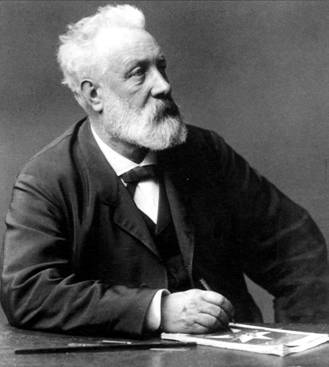Jules Verne and Astronomy
Notes and comments on the astronomical novels of
Jules Verne
version en français

Jules Verne (1828–1905)
These pages are not a thorough analysis of astronomy in the novels
of Jules Verne. They are just reading notes, to show how JulesVerne,
who was basically not learned in science, understood astronomy from
contemporaneous publications. They try to disentangle what was correct
or erroneous, what was known or ignored at that time.
I do no have the time (nor the skill) to provide now a complete translation
of my pages into English. I just give below a short summary, with
highlights and appropriate links to the pages in French.
Several novels of Jules Verne in which astronomy takes a major place are
listed below. In addition, many novels refer incidentally to astronomy,
geodesy or atmospheric phenomena.
De la Terre à la Lune
(1865) and Autour de la Lune
(1870).
From the Earth to the Moon and Around the Moon are the first
astronomical novels of Jules Verne.
Les Aventures de trois Russes et de trois
Anglais dans l'Afrique Australe (1872).
Adventures of Three Englishmen and Three Russians in Southern Africa
describes the life of six astronomers whose task is to measure a portion of
the Earth meridian in South Africa. It is based upon the expeditions of
Delambre, Méchain, Arago and their predecessors, and it can be
considered as a tribute to Arago.
Le Pays des fourrures (1873).
The Fur Country describes a failed observation of the solar eclipse
of 18 July 1860 in north Canada. Jules Verne apparently mistook the
visibility conditions of the eclipse, which was not total at this place. He
was not aware of an american expedition to Labrador to observe this
eclipse.
Le Tour du Monde en quatre-vingt
jours (1873).
Around the World in Eighty Days is based upon a cosmographic
joke taken from a tale of Edgar Allan Poe (Three Sundays on a
Week).
Hector Servadac (1877).
Hector Servadac (aka To the Sun? and Off on a Comet!)
describes the in situ exploration of a cometary nucleus by
astronomer Palmyrin Rosette, well before the Rosetta space mission.
Les Cinq cents millions de la
Bégum (1879).
In The 500 Millions of the Begum, an artificial satellite
is unexpectedtly launched. This reminds us of the cannon thought experiment
imagined by Isaac Newton.
Le Rayon-vert (1882).
The Green Ray revealed for the first time this atmospheric
phenomenon to a large public. The green ray is also mentionned in four other
novels of Jules Verne. We still do not know precisely what drew Jules
Verne's attention to this topic.
Sans dessus dessous (1889).
Topsy-Turvy (aka The Purchase of the North Pole) included in
its original edition a Supplementary Chapter (not available in the
English translations), written by Albert Badoureau, which provided physical
and astronomical details with all necessary mathematics. This chapter is a
feasibility study supposed to prevent possible objections from
scientific experts. It contains several errors, however.
Mirifiques Aventures de Maître
Antifer (1894).
The plot of Mirifiques Aventures de Maître Antifer is a
geodesic enigma, which requires the use of spherical trigonometry to be
rigorously solved.
La Chasse au météore
(1908).
The Chase of the Golden Meteor (aka The Hunt for the Meteor)
was published after the death of Jules Verne in a version highly edited and
modified by his son Michel. (The original version of Jules Verne is now
also available.) It tells the rivalry between two amateur astronomers who
both discovered a bolid (in fact an asteroid). The asteroid (like the comet
in Hector Servadac) is made of gold. The announcement of its fall on
Earth provokes a financial crisis.
Notes on novels in which astronomy is not
the main topic, but where there are significant references to astronomy
or related sciences.
Bonus :
Plays and movies from De la
Terre à la Lune and Autour de la Lune.
Voyage à
Vénus (1865) by Achille Eyraud.
Voyage to Venus, published the same year as From the Earth to
the Moon, makes use, for the first time, of a genuine rocket for an
interplanetary travel.
Prodigieuse Découverte
(1867) by Armand Audoy.
It was considered for
some time that Prodigious Discovery was written by Jules Verne.
Les Exilés de la
Terre (1888) by André Laurie.
The Conquest of the Moon, a story of the Bayouda was to be published
by Hetzel as one of the Voyages extraordinaires, but Jules Verne
refused to co-author this novel. A magnetic mountain is converted into a
gigantic electromagnet to attract the Moon...
More to come! These pages are continuously updated.
Bibliography in English:
A summary of these notes Astronomy and astronomers in Jules Verne's
novels was presented at the International Astronomical Union Symposium
260 (The Rôle of Astronomy in Society and Culture, 19–23
January 2009, UNESCO, Paris) and is published in the proceedings;
a preprint is freely available:
arXiv:0906.1052
A poster on Planets, comets ans small bodies in Jules Verne's
novels was presented in Nantes at the ESPC-DPS international meeting on
planetary sciences (2–7 October 2011). See the abstract
and the poster.
© 2004—2022 Jacques
Crovisier

